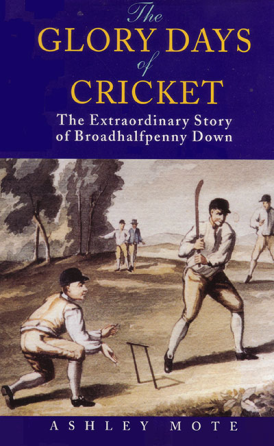The Glory Days of Cricket
Martin Chandler |Published: 2015
Pages: 442
Author: Mote, Ashley
Publisher: JT Associates
Rating: 3.5 stars

It was only a few years before this book was published that I first found myself in Hambledon. I had been to Portsmouth for the day and had agreed with some old friends who had just moved to Winchester that on my way home I would pay them a visit. I finished my business in Portsmouth earlier than I had expected so meandered back via the relatively quiet minor roads rather than going back on the busy M3. Having been a cricket lover all my life I can’t explain why it had never occurred to me to visit the place before, but for whatever reason it was only when I passed a sign telling me Hambledon was a mile on my left that, with time on my hands, the thought crystallised in my mind.
So I took the left turn and soon arrived in a small and, at first sight, unremarkable Hampshire village. But then I saw the Bat and Ball Inn that I had heard of so often, and I soon worked out where the historic Broadhalfpenny Down was. There was no sign of any cricket, if for no other reason than it was a grey and cold November day, but I was immediately conscious of a very special atmosphere. It wasn’t quite like the way the hairs on the back of my neck stand up and I find my voice disappearing every time I walk into Lord’s, but despite the fact there wasn’t another soul in sight, other than the odd driver passing by, I still had a feeling of being amongst friends. I walked briefly around the village before enjoying a cup of coffee amidst the memorabilia in the famous hostelry, and then set off again for my rendezvous in Winchester.
Other than that Hambledon, in general terms, had much to do with cricketing pre-history I had little idea that afternoon in the early 1990s as to exactly what role the village had played in the development of the game. I knew rather more after spending twenty minutes looking around the Bat and Ball, but it wasn’t until a few years later, when Ashley Mote’s book appeared, that I got to grips with exactly what the story was. Even then it was only due to my first mother-in-law, thinking The Glory Days of Cricket must have referred to the heady days of 1981, that I was given Mote’s book for Christmas.
So why is Hambledon important? It is not, as I initially assumed, because it was the birthplace of the game, and Mote is very swift to correct anyone who may be under that misapprehension. It is however where cricket as we know it today began to take shape as, for a brief interlude in the second half of the 18th century, the small Hampshire village could put out on the cricket field a side that could, and often did, beat All-England. They weren’t all local men of course. Those who were the club’s greatest patrons could afford to hire the best players for miles around, and added to that mine host at the Bat and Ball, Richard Nyren, was a very fine cricketer as well.
By the end of the 18th century the magic was gone. Richard Nyren packed himself off to London in 1791. The last major cricket match to take place on Broadhalfpenny down was played the following year and big cricket became firmly established at a ground in the capital founded by one Thomas Lord. Hambledon was, after a quarter of a century of “Glory Years”, just a normal village cricket team again, although forty years later new ground was broken once more. In 1832, in the name of Nyren’s son, John, The Cricketers of my Time was published. It was the first book about the game, other than instructional texts or collections of scores, that ever appeared, and thanks to it the first hand memories of those who witnessed the “Glory Years” were recorded forever. The first edition of the book is, not unnaturally, one of the most prized cricket books there is, but it is considered to have such importance it has been re-published more than once, most recently with a new introduction penned by none other than Mr Mote, in 1998.
Ashley Mote was not the first man by any means to be captivated by the lure of the Hambledon story, but no one since since the noted historian Ashley-Cooper back in 1907 had devoted an entire book to the subject. Others had however drilled into aspects of the subject in the intervening years and with their work and his own considerable research Mote produced a fascinating history which deservedly won the Cricket Society Book of the Year Prize for The Glory Days of Cricket . So why a second edition? Well there have been a few developments since 1997 and those result in an additional chapter. These are not new discoveries extracted from ancient archives but an updating of the story of Broadhalfpenny Down to cover the events of the last 17 years, and a digression on the subject of The Cricketers of My Time. Whether the new chapter will prove as controversial as Mote believes I am not so sure, but it certainly displays his great passion for his subject.
For those interested in the game’s progress towards the very commercial activity it is today, or just in the way cricket was played in those far off days this is certainly recommended. As to the author Mote himself is an interesting character, and whilst I doubt he and I will ever inhabit the same area of the political spectrum, I would certainly be interested in reading his autobiography one day.






Leave a comment